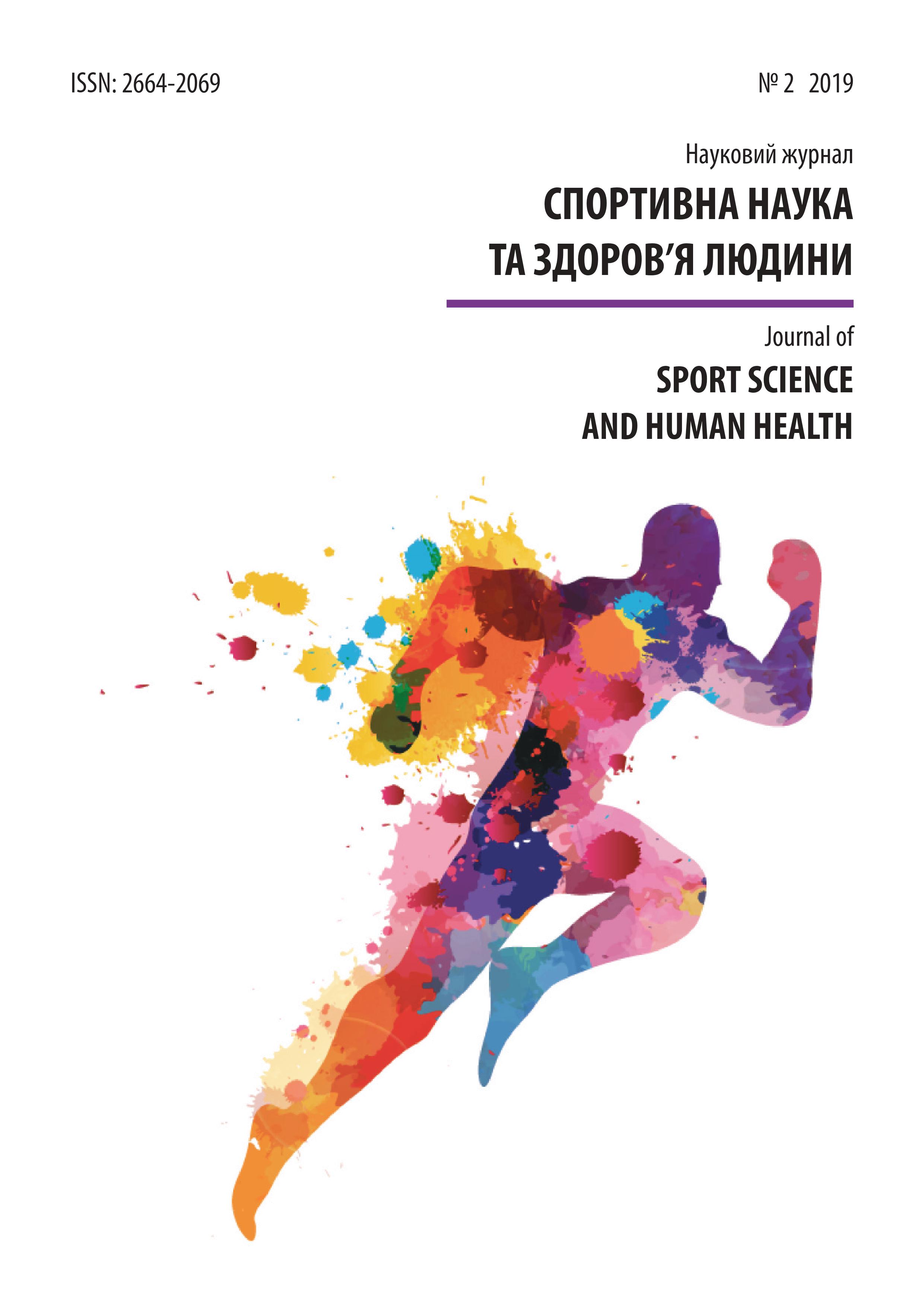RISK FACTORS IN HUNGARIAN ELITE RYTHMIC GYMNASTIC FROM PSYCHOLOGICAL ASPECT THE RELATION AMONG BODY IMAGE, MOTIVATION, BURN-OUT AND PERCEIVED COACH AND PARENT-AUTONOMY SUPPORT
DOI:
https://doi.org/10.28925/2664-2069.2019.2.11Ключові слова:
художня гімнастика, мотивація, прийняття самостійної підтримки, вигоряння, поведінка тіла.Анотація
Що стосується естетичних видів спорту, то ритмічна гіманстика є одним із найскладніших видів спорту та передбачає найбільший ризик порушення харчування та вигоряння. У випадку молодіжного спорту мотиваційний клімат та сприйняття підтримки автономії вважаються важливими факторами психологічного розвитку.
Мета - дослідити зв’язок образу тіла, мотивації та вигоряння художніх гімнасток із рівнем сприйняття підтримки автономії тренерами та батьками.
Методи. Вибірка складається з елітних спортсменів з художньої гімнастики (N=26; середній вік=16,34; SD=2,00). Застосовані такі затверджені анкети: опитувальник спортивного клімату; шкала сприйняття підтримки автономії для підбору вправ; опитувальник завдання та его орієнтації у спорті; опитувальник на вигоряння спортсмена; тест ставлення до тіла.
Результати. Встановлено значну, негативну, середню асоціацію між рівнем сприйнятття підтримки автономії та шкалою девальвації, тоді як взаємозв'язок між рівнем сприйняття підтримки самостійності (з боку тренерів та батьків) та ставленням до тіла був значним, позитивним.
Висновки. Позитивне співвідношення рівня сприйняття підтримки самостійності та ставлення до тіла може означати амбівалентну якість відносин спортсмен-батько та спортсмен-тренер. Негативне співвідношення рівня сприйняття самостійності та девальвації виявляє важливість комунікації та зворотного зв'язку в самооцінці спортсмена.
Посилання
Atkins M, Johnson D, Force E, Petrie T. Peers, parents, and coaches, oh my! The relation of the motivational climate to boys' intention to continue in sport. Psychology of Sport And Exercise. 2015; 16:170-180. http://dx.doi.org/10.1016/j.psychsport.2014.10.008
Cheon SH, Reeve J, Lee J, Lee Y. Giving and receiving autonomy support in a high-stakes sport context: a field-based experiment during the 2012 London Paralympic Games. Psychology of Sport and Exercise. 2015; 19, 59-69.
De Bruin A, Bakker FC, Oudejans RRD. (2009). Achievement goal theory and disordered eating: Relationships of disordered eating with goal orientations and motivational climate in female gymnasts and dancers. Psychology of Sport and Exercise. 2009; 10(1): 72-79. doi:10.1016/j.psychsport.2008.07.002
Deci RM. The sport climate questionnaire, 2001; Retrieved February 3, 2018 from: http://www.psych.rochester.edu/SDT/measures/auton_sport.html
Dubuc NG, Schinke RJ, Eys MA, Battochio R, Zaichkowsky L. Experiences of burnout among adolescent female gymnasts: Three case studies. Journal of Clinical Sport Psychology. 2010; 4:1–18.
Duda JL. Relationship between task and ego orientation and the perceived purpose of sport among high school athletes. Journal of Sport and Exercise Psychology. 1989; 11: 318-335.
Feeley BT, Agel J, LaPrade RF. When Is It Too Early for Single Sport Specialization?, The American Journal of Sports Medicine. 2016; 44(1): 234-41. https://doi.org/10.1177/0363546515576899
Fejes JB. Célok és motiváció - Tanulási motiváció a célorientációs elmélet alapján. Budapest: Gondolat Kiadói Kör; 2015. 21.p.
Fenton SAM, Duda JL, Quested E, Barrett T. Coach autonomy support predicts autonomous motivation and daily moderate-to-vigorous physical activity and sedentary time in youth sport participants. Psychology of Sport and Exercise. 2014; 15: 453-463.
Gustafsson H, DeFreese JD, Daniel DJ. Athlete burnout: review and recommendations, Current Opinion in Psychology. 2017; 16: 109-113. https://doi.org/10.1016/j.copsyc.2017.05.002
Hagger MS, Chatzisarantis NL, Hein V, Pihu M, Soós I, Karsai I. The perceived autonomy support scale for exercise settings (PASSES): Development, validity, and cross-cultural invariance in young people. Psychology of Sport and Exercise. 2007; 8(5): 632-653. doi:10.1016/j.psychsport.2006.09.001
Joy E, Kussman A, Nattiv A. 2016 update on eating disorders in athletes: A comprehensive narrative review with a focus on clinical assessment and management. British Journal of Sports Medicine. 2016; 50(3): 154-162. doi:10.1136/bjsports-2015-095735
Kipp LE, Weiss M. Social predictors of psychological need satisfaction and well-being among female adolescent gymnasts: A longitudinal analysis. Sport, Exercise, and Performance Psychology. 2016; 4(3):153-169.
Kong P, Harris LM. The Sporting Body: Body Image and Eating Disorder Symptomatology Among Female Athletes from Leanness Focused and Nonleanness Focused Sports, The Journal of Psychology. 2015; 149:2: 141-160. DOI: 10.1080/00223980.2013.846291
Nowicka P, Eli K, Ng J, Apitzsch E, Sundgot-Borgen J. Moving from Knowledge to Action: A Qualitative Study of Elite Coaches Capacity for Early Intervention in Cases of Eating Disorders. International Journal of Sports Science & Coaching. 2013; 8(2): 343-355. doi:10.1260/1747-9541.8.2.343
O’Rourke DJ, Smith RE. Parent-initiated Motivational Climate and Young Athletes Intrinsic-Extrinsic Motivation: Cross-sectional and Longitudinal Relations. Journal of Child and Adolescent Behaviour. 2013; 1(2). doi:10.4172/2375-4494.1000109
Probst M, Vandereycken W, Van Coppenolle H, Vander-linden J. The Body Attitude Test for patients with aneating disorder: Psychometric characteristics of a newquestionnaire. Eat. Disord. 1995; 3: 133–145.
Raedeke TD, Smith AL. Development and Preliminary Validation of an Athlete Burnout Measure. Journal of Sport and Exercise Psychology. 2001; 23(4): 281-306. doi:10.1123/jsep.23.4.281
Ryan RM, Deci EL. Self-Determination Theory: Basic Psychological Needs in Motivation, Development, and Wellness. NewYork:Guilford; 2017. 17.p.
Scoffier S, Corrion K, D’Arripe-Longueville F. Effects of achievement goals on female aesthetic athletes’ disordered eating attitudes. Science & Sports, 2013; 28(6): 151-157.doi:10.1016/j.scispo.2013.04.001
Schwebel FJ. Smith RE, Smoll FL. Measurement of Perceived Parental Success Standards in Sport and Relations with Athletes’ Self-Esteem, Performance Anxiety, and Achievement Goal Orientation: Comparing Parental and Coach Influences. Child Development Research. 2016, 1-13. doi:10.1155/2016/7056075
Stambulova N, Stambulov A, Johnson U. ‘Believe in Yourself, Channel Energy, and Play Your Trumps’: Olympic preparation in complex coordination sports. Psychology of Sport and Exercise. 2012; 13(5): 679-686. doi:10.1016/j.psychsport.2012.04.009
Sundgot-Borgen J, Torstveit MK. Prevalence of eating disorders in elite athletes is higher than in the general population. Clinical Journal of Sport Medicine. 2004; 14, 25–32.
Tan J, Bloodworth A, Mcnamee M, Hewitt J. Investigating eating disorders in elite gymnasts: Conceptual, ethical and methodological issues. European Journal of Sport Science. 2014; 14(1): 60-68. doi:10.1080/17461391.2012.728632
Thompson RA, Sherman R. Reflections on athletes and eating disorders. Psychology of Sport and Exercise. 2014; 15(6): 729-734. doi:10.1016/j.psychsport.2014.06.005
Thomson P, Kibarska LA, Jaque SV. Comparison of dissociative experiences between rhythmic gymnasts and female dancers. International Journal of Sport and Exercise Psychology. 2011; 9(3): 238-250. doi:10.1080/1612197x.2011.614850
Weinberg RS, Gould DS. Foundations of sport and exercise psychology. Human Kinetics: 2018., 252.p.











